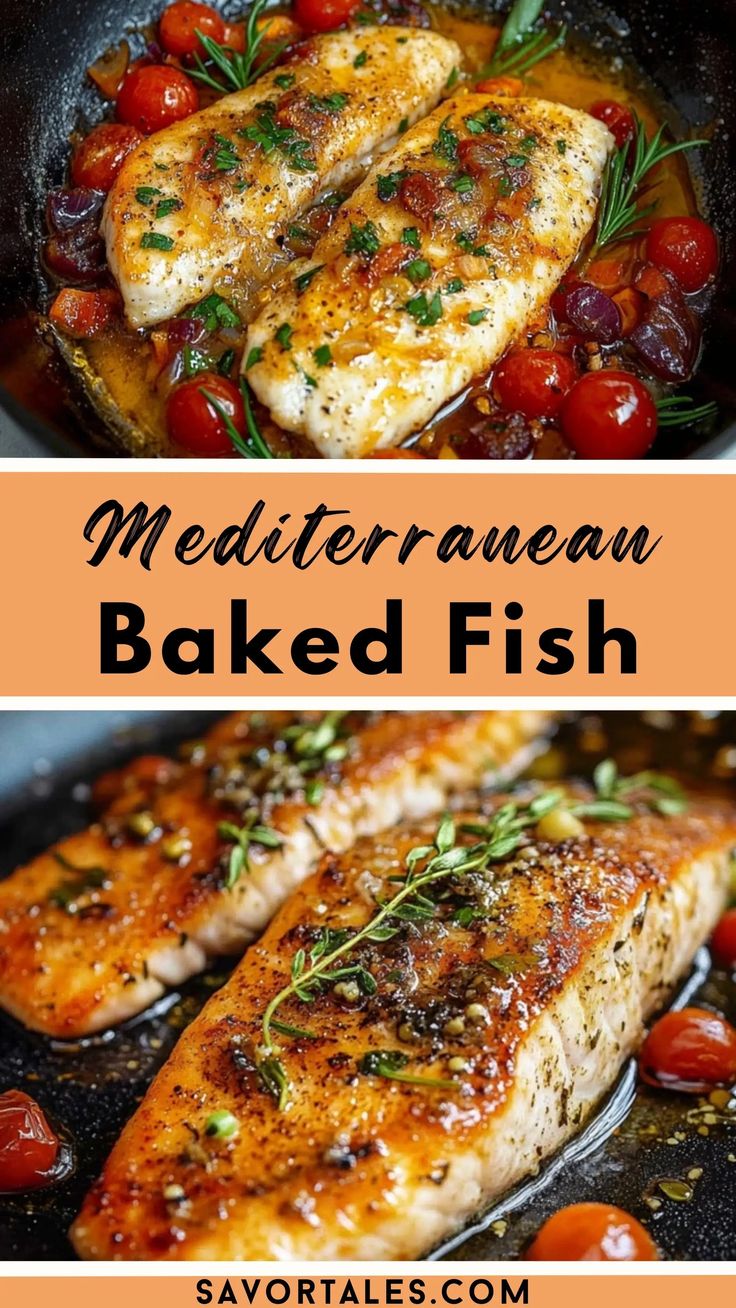
The Night That Changed My Kitchen Forever
The first time I tasted Mediterranean baked fish, I was twenty-two, sunburned, and perched at a wobbly table in a Santorini taverna, the Aegean Sea glinting under a twilight sky. The air was thick with salt, grilled octopus, and the laughter of strangers who felt like family after a glass of ouzo. The dish—a plump cod fillet baked in a clay dish with lemon, herbs, and tomatoes—arrived like a revelation. Yiannis, the chef, his hands rough as driftwood, leaned over and said, “This is my mother’s recipe. Let the fish sing.” I burned my tongue on the first bite, too eager to wait, and the flavors—bright, briny, and soul-warming—etched themselves into my memory. I’ve spent years chasing that dish, from cramped apartment kitchens to professional stoves, learning its secrets through trial, error, and a few scorched pans. This recipe isn’t just food; it’s a story of connection, patience, and the kind of cooking that makes you feel alive.
Mediterranean baked fish is deceptively simple, but it’s a masterclass in balance—acidic lemon, earthy herbs, and silky olive oil elevate the fish without overpowering it. Whether you’re a home cook nervous about fish sticking to the pan or a seasoned chef looking for a dish that sings, I’ll share every tip, mistake, and workaround I’ve learned over decades in the kitchen. This is about creating something meaningful, not just a meal.
Why Mediterranean Baked Fish Stands Out
What makes this dish unique? It’s the Mediterranean in a bite—Greece, Italy, Spain, Morocco—where the sea meets the land in perfect harmony. The fish, whether cod, snapper, or sea bass, is baked with a vibrant mix of olive oil, lemon, garlic, tomatoes, and herbs like oregano and thyme. It’s not drowned in heavy sauces or masked by spice; it’s clean, bright, and lets the fish shine. The slow bake melds the flavors into a jammy, aromatic sauce that’s both rustic and refined. Unlike grilling or frying, baking keeps the fish tender and forgiving—miss a minute, and it still works. This dish is a reminder that simple ingredients, treated with care, can become extraordinary.
Ingredients: The Soul of the Dish
Every ingredient here carries weight, and I’ve learned their quirks through years of sourcing, tasting, and tweaking. From bustling markets in Athens to my local grocery store, here’s how to choose wisely.
- Fish (1.5–2 lbs, cod, snapper, or sea bass): Freshness is everything. Look for clear eyes, bright red gills, and a clean, ocean-like smell. Cod’s flaky, mild texture is my favorite for this dish, but snapper’s subtle sweetness or sea bass’s richness are close contenders. Frozen fish? Thaw it slowly in the fridge for 24 hours to preserve texture, but fresh is always brighter. If you’re far from the coast, ask your fishmonger for the day’s best catch. Pro tip: I once used day-old fish, and the flavor was muted—don’t skimp on freshness.
- Extra Virgin Olive Oil (1/3 cup, Greek or Spanish): This is the dish’s backbone. I love Kalamata or Cortijo de Suerte Alta for their peppery, grassy notes. Cheap oil tastes greasy and flat; spend a little more for one that sings of olives and sunshine. A good test? Drizzle it on bread—if it’s delicious raw, it’s perfect here.
- Lemons (2, fresh): Juice one, slice the other, and zest both for maximum brightness. Standard lemons give the sharp acidity this dish needs; Meyer lemons are too sweet. Organic is ideal for zesting to avoid waxy coatings. I learned this the hard way when a waxy lemon left a bitter aftertaste.
- Garlic (4 cloves, minced): Fresh only—pre-minced from a jar lacks soul. Mince finely and cook gently; I burned the garlic once, and the dish turned acrid. Low heat is your friend.
- Cherry Tomatoes (1 pint, halved): These burst in the oven, creating a jammy, sweet-tart sauce. Heirloom varieties add visual pop, but any ripe, sweet ones work. Out of season? Canned San Marzano tomatoes, well-drained, are a solid backup. I’ve used them in winter and still got raves.
- Kalamata Olives (1/2 cup, pitted): Their briny punch screams Greece. Rinse them if they’re overly salty. No Kalamatas? Castelvetrano olives are milder but still delicious. I once skipped olives entirely, and the dish felt incomplete—don’t skip the brine.
- Fresh Herbs (oregano, thyme, parsley): Fresh oregano and thyme go in the oven for depth; parsley’s sprinkled at the end for brightness. Dried herbs work (use half the amount), but fresh is transformative. I grow mine in a windowsill pot—snip gently to keep the plant thriving.
- White Wine (1/4 cup, dry): A crisp Pinot Grigio or Sauvignon Blanc adds nuance without dominating. No wine? Vegetable broth with a splash of white vinegar mimics the acidity. I tried water once, and the sauce lacked soul.
- Sea Salt and Black Pepper: Maldon sea salt’s flaky crunch is my go-to. Freshly ground pepper is sharper and more aromatic than pre-ground. Don’t over-salt; the olives and feta (if using) bring plenty.
- Optional: Feta Cheese (1/4 cup, crumbled): A Greek classic, Dodoni feta adds creamy tang. Skip it for a lighter or dairy-free version, but it’s a crowd-pleaser. I once overdid the feta, and it overwhelmed the fish—less is more.
Substitutions That Keep the Magic
- No cod or snapper? Tilapia or haddock work, but cook thinner fillets for less time (15–20 minutes). Avoid salmon; its oiliness clashes with the bright flavors.
- No fresh herbs? Dried oregano and thyme are fine at half the amount, but fresh parsley is non-negotiable for that final burst.
- No olives? Capers (2 tablespoons, rinsed) offer a similar briny kick, though they’re sharper.
- No wine? Broth plus a teaspoon of lemon juice does the trick. I’ve used this swap at family dinners with no complaints.
Tools: What You Need (And What You Don’t)
You don’t need a high-end kitchen to nail this dish. I’ve made it in a tiny apartment with a temperamental oven and in a professional setup with a Le Creuset Dutch oven. Here’s the lineup:
- Baking Dish: A 9×13-inch ceramic or glass dish is ideal for even heat and pretty presentation. A Lodge cast-iron skillet works, too, but preheat it to prevent sticking. I once used a flimsy aluminum tray, and the fish stuck like glue—invest in something sturdy.
- Sharp Knife: For slicing tomatoes and lemons. My Wüsthof has been my trusty sidekick for years.
- Microplane: For lemon zest. No Microplane? A fine grater or vegetable peeler (then chop finely) works, but it’s slower.
- Tongs: For gently handling the fish. I Juno, I’ve used forks, but they can tear the fillets.
Do I need a tagine? Not at all. A tagine’s clay steams beautifully for Moroccan-style dishes, but a standard baking dish nails the Greek or Italian vibe here. If you have a tagine, try it for fun—it traps moisture and intensifies flavors—but it’s not necessary.
Step-by-Step: Cooking with Love and Wisdom
This recipe serves 4 and takes about 45 minutes, including prep. Preheat your oven to 375°F (190°C). Let’s get cooking.
Step 1: Build the Flavor Foundation
Pour 2 tablespoons of olive oil into your baking dish and swirl to coat. Scatter the minced garlic evenly—it’s the base of your sauce. Arrange the halved cherry tomatoes, cut-side up, for caramelized sweetness. Add the olives, 1 tablespoon of chopped oregano, and 1 teaspoon of thyme. Drizzle another tablespoon of oil over the top. Take a moment to arrange the tomatoes neatly; I once tossed them in haphazardly, and the dish looked sloppy despite tasting great. Presentation matters.
Step 2: Prep the Fish
Pat the fish fillets dry with paper towels—wet fish steams, not bakes, and you’ll miss that golden edge. Season both sides with sea salt and black pepper. Lay the fillets skin-side down (if applicable) on the tomato mixture, nestling them snugly but not overcrowded. If the fillets vary in thickness, tuck thinner ends under for even cooking. I learned this after overcooking a thin cod tail—patience pays off.
Step 3: Crown with Flavor
Pour the white wine over the fish; it’ll meld with the tomatoes into a luscious sauce. Squeeze one lemon’s juice over everything, then scatter the zest for extra zing. Slice the second lemon thinly and lay the slices over the fish like a fragrant blanket. Drizzle the remaining olive oil on top. Don’t skip the lemon slices—I did once, and the dish lacked that bright, sunny spark.
Step 4: Bake with Care
Cover loosely with foil to keep the fish moist, but don’t seal it tight—some steam should escape. Bake for 20–25 minutes, checking at 20 minutes. The fish should flake easily with a fork and reach 145°F (63°C) internally. If using feta, crumble it over the top in the last 5 minutes to warm without melting. I once overbaked snapper, and it turned dry—check early to be safe.
Step 5: Finish with Flair
Remove the foil and sprinkle with chopped parsley. Let the dish rest for 5 minutes to let the juices settle. Serve straight from the dish for that rustic Mediterranean vibe, or plate with a spatula for elegance. Scrape up the sauce—it’s liquid gold.
Common Mistake: Rushing the prep. Take time to dry the fish and arrange the ingredients. A hurried dish lacks soul, and I’ve learned this through too many frantic weeknight dinners.
Pairings, Variations, and Serving Ideas
What drinks pair well with this dish? A crisp white wine like Pinot Grigio, Sauvignon Blanc, or Assyrtiko from Greece complements the lemony brightness. For a non-alcoholic option, try sparkling water with a lemon wedge or a light herbal tea like chamomile. I once paired this with a heavy red wine, and it clashed—stick to light and crisp.
Side Dishes: Serve with roasted potatoes tossed in olive oil and rosemary or a simple Greek salad with cucumbers, red onion, feta, and a lemon-oregano dressing. For a Moroccan twist, pair with couscous mixed with preserved lemon and mint. Grilled zucchini or asparagus adds color and crunch.
Variations:
- Greek Style: Add feta and a pinch of cinnamon to the tomato mixture for warmth.
- Italian Style: Swap oregano for basil and add a handful of capers for extra zing.
- Moroccan Style: Use a tagine (if you have one) and add preserved lemons and a pinch of saffron. I tried this at a friend’s house in Marrakech, and it was unforgettable.
- Gluten-Free: Naturally gluten-free, just double-check your broth or wine.
- Vegetarian: Swap fish for thick slices of eggplant or portobello mushrooms—bake for 15–20 minutes.
Serving Tip: Serve family-style in the baking dish with crusty bread to soak up the sauce. I once served it without bread, and my guests were scraping the dish with spoons—don’t make them suffer.

